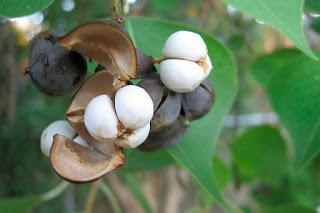Here We Go Again!
As if Chamberbitter was not bad enough, there is ANOTHER bad weed popping up all over the place. It is probably right under your nose, or over your head, depending on how far along it has gotten.
Have you seen this plant/leaf?
 If spotted, remove immediately!!Photo by Darren Sheriff
If spotted, remove immediately!!Photo by Darren SheriffIt is not armed, but can be dangerous to your yard.
This plant is Sapium sebiferum, also know as the Chinese Tallow Tree, or Popcorn Tree. Why do they have to ruin the reputation of a good food by associating it with a bad plant!?!?
You can also find it still listed as Triadica sebifera, but the Sapium sebiferum is the proper name.
The Popcorn tree is native to China and Japan where it has been cultivated for its useful seeds and as an ornamental for more than a thousand years. It is said that Benjamin Franklin introduced it into the United States in 1776 for use of its waxy tallow in soaps and candles.
It is a deciduous tree (loses its leaves) that may reach 60 feet in height. The bark is a light gray. It has heart-shaped leaves with a pointed tip.

Photo by Darren Sheriff
Slender, drooping spikes up to 8 inches long appear from April to June.
 Photo Courtesy of Mississippi State University
Photo Courtesy of Mississippi State UniversityIn Fall the leaves turn brilliant shades of scarlet, orange, yellow and maroon.
Popcorn Trees can invade a variety of habitats ranging from swampy to saline waters, and from full sun to shade situations. It is often found growing along roadsides, coastal areas, and streams. Larger specimens can produce up to 100,000 seeds that may be eaten and dispersed by birds, facilitating the spread. Native species are crowded out once the Chinese Tallow becomes established. The leaves and fruit are toxic to cattle and cause nausea and vomiting in humans.It tolerates almost any soil and can grow 5 feet tall in its first year. They are considered moderately drought tolerant. However, It was planted as a street tree in California where it apparently has not yet become invasive, perhaps because of insufficient rainfall.
Why have they become so invasive, first off, being that they are a native of Eastern Asia, which is the same latitudes as the Southeastern U.S. they love the growing conditions here, but primarily because of the seeds that are readily eaten and dispersed by birds. The seeds also float and can be carried easily by rivers, streams, and storm water runoff to new destinations and virtually all of them will germinate somewhere.
The seeds are in a fruit that are 3 lobed, brown capsules, 1/2 inch in diameter, when mature the outer part splits revealing 3 white waxy seeds that resemble popcorn, hence its common name.
 Photo Courtesy of https://www.pinterest.com/houselogic/
Photo Courtesy of https://www.pinterest.com/houselogic/They mature in late Summer to early Fall.
If all of this is not bad enough, The leaves produce allelopathic chemicals that will change soil content and therefore making the area uninhabitable to native species.It has gotten so bad that, the State of Florida lists the Popcorn Tree or Chinese Tallow as a noxious weed and prohibits its introduction, movement or release.
To kill these things, cut the tree down and immediately paint the stump with a triclopyr herbicide such as Brush-B-Gon, Garlon, Pathfinder, Chopper or something like Roundup Poison Ivy Plus Tough Brush Killer. Make sure you follow the label directions or get a certified professional to apply these. Results also can be obtained by spraying the bark in a 6 inch wide band all around the base of the trunk with one of the triclopyr herbicides. I don't usually suggest such harsh treatment because of the danger it can pose to the homeowner and the landscape, BUT, tests of simply cutting down the trees resulted in extensive root and stump sprouting. Before applying any herbicide, read the label!! I can not emphasize this enough.
This is nasty tree. Yes, it has pretty Fall foliage and can be used for some good shade. Tree species recommended that are similar in size to Chinese Tallow include Maples (Acer spp.) and Crape Myrtles (Lagerstroemia spp.). Might I also suggest to use an Eastern Redbud (Cercis canadensis), or a Red Mulberry (Morus rubra) instead. Even though it is considered a messy tree, at least the Red Mulberry will give you something good to eat!
If you have any questions regarding this or any of my other articles, please don't hesitate to drop me a line to [email protected]
Happy Growing!
Darren

